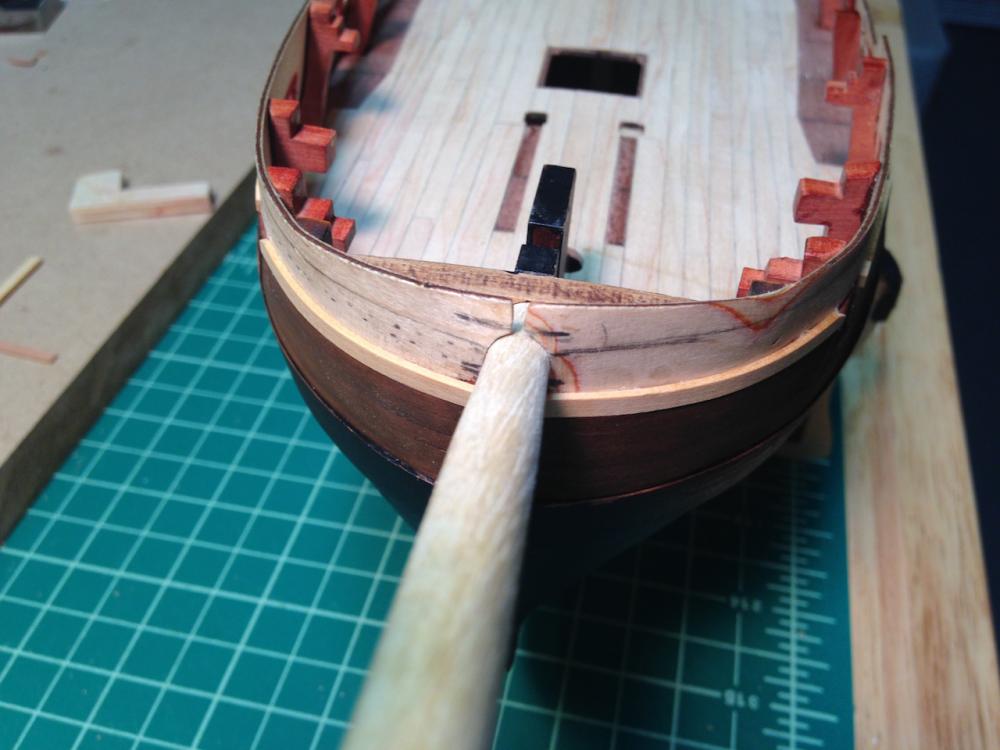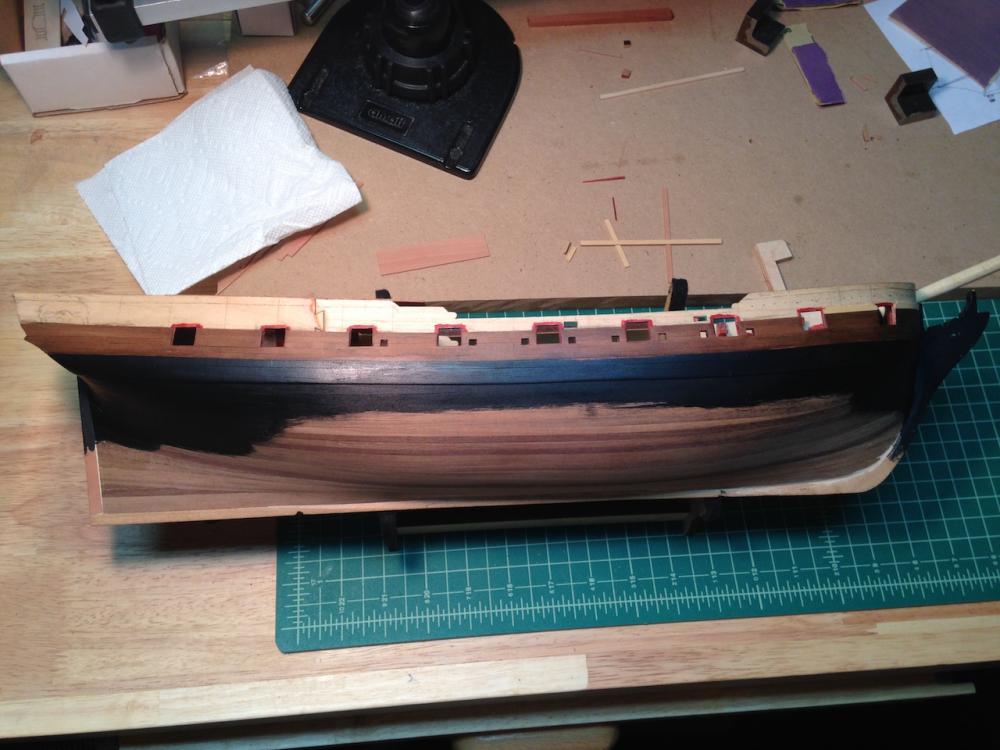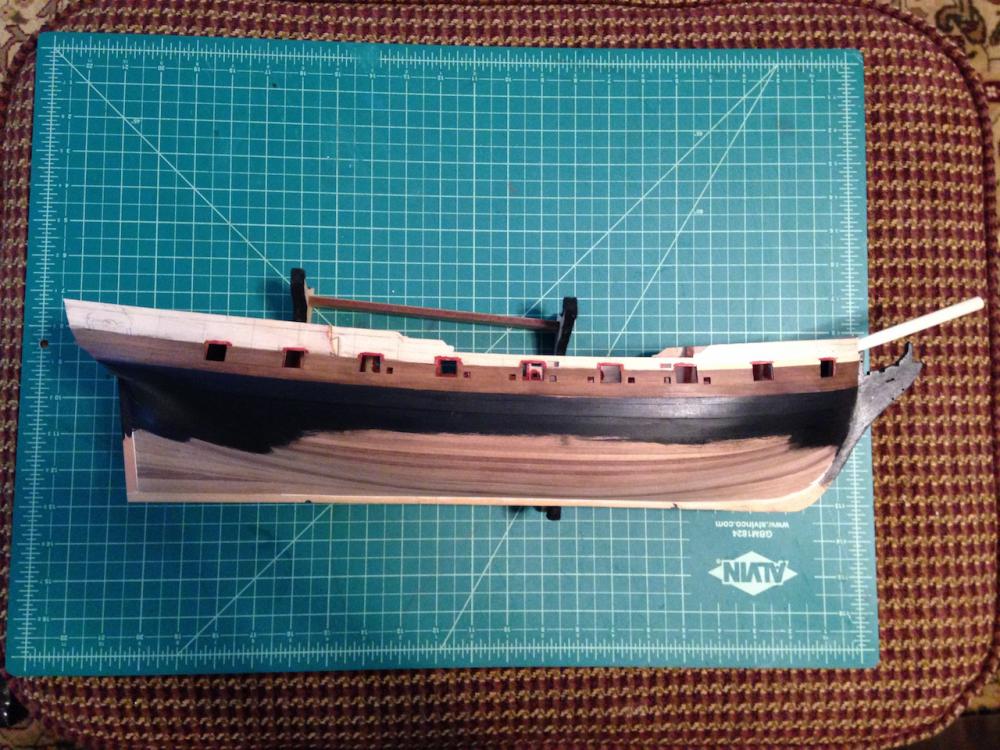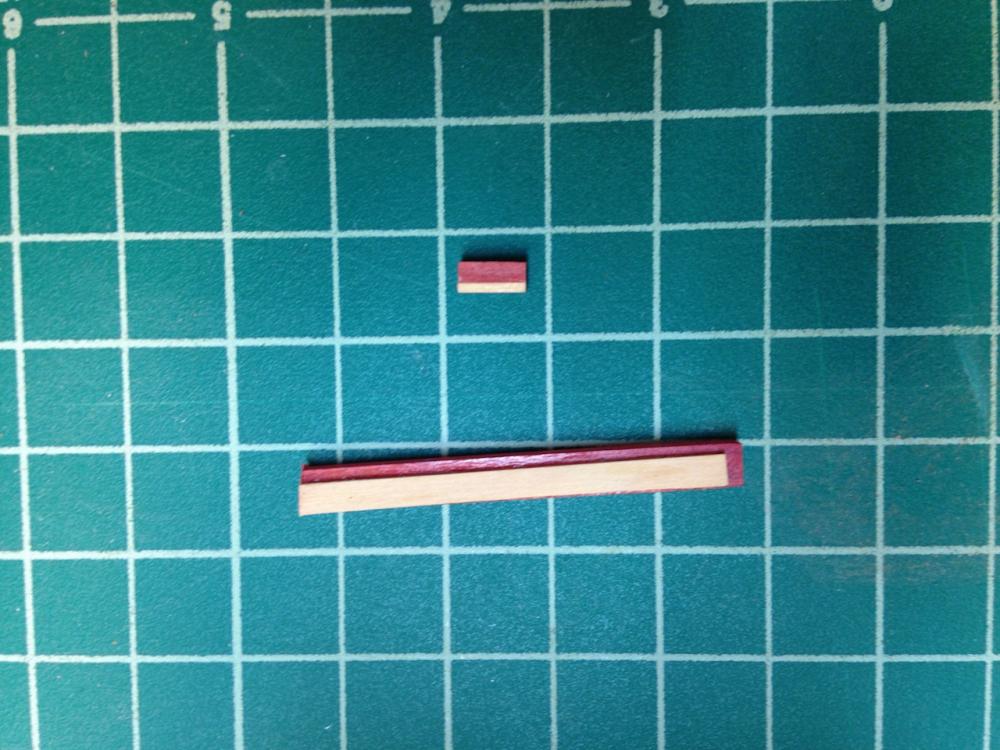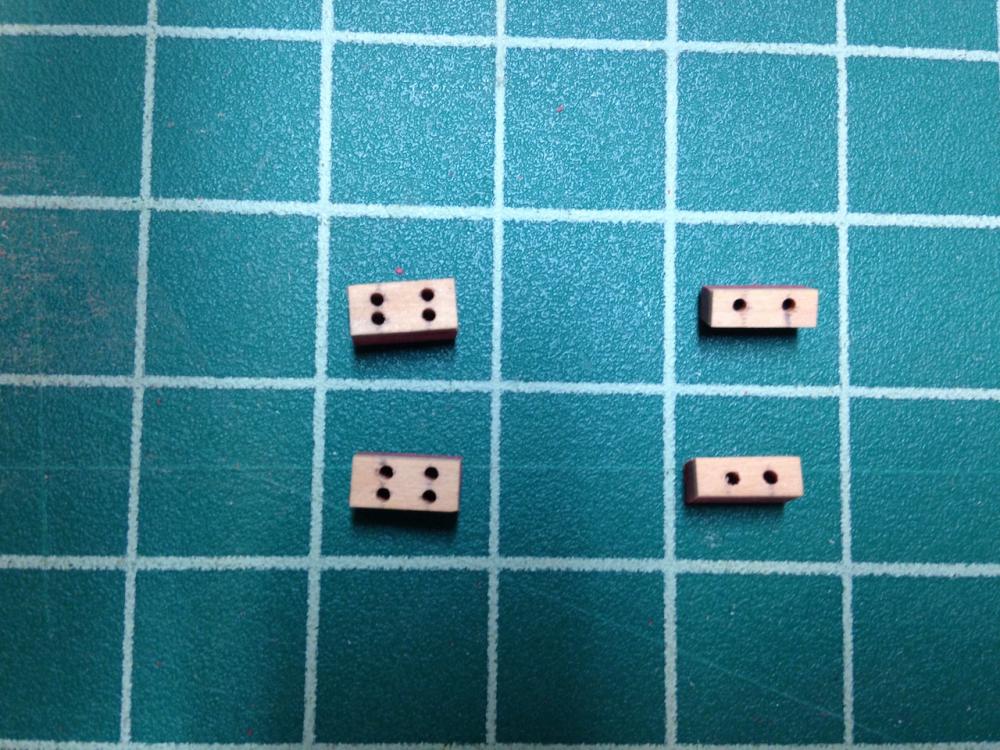-
Posts
4,540 -
Joined
-
Last visited
Content Type
Profiles
Forums
Gallery
Events
Everything posted by Landlubber Mike
-
Thanks BE. That picture really helps. I must have mis-measured my rail lines, or perhaps my gunport patterns are slightly off from where they should have been installed.I had to open up the bowsprit hole so I think I must have been a bit off. By the way, really clean lines, wow. You really set the bar high for the rest of us
-
Really gorgeous work Mark. Those windows are amazing. Are they one piece? Really precise work with the laser cutter. I've been thinking ahead towards how I will do the windows on my Pegasus, and I think I found the answer - I'll just send the plans to you to do them for me By the way, I think you're ready for carving With all the detail on the model, I think carving would really be the icing on the cake.
-
Thanks Mark. Really great idea. I was using a regular drill bit, and not a milling bit. I thought about doing that, but I will have to sand the block back to get it to fit into the surrounding planking, so I don't know how deep to go with the connection just yet. I was thinking about using a small file once the blocks are installed and sanded back to do so (maybe starting them ahead of installing them).
-
Thanks very much BE. You're right that I should hold off as I can always sand things down later. I couldn't tell from your pictures, but does the area above the drift rail (what you painted red) get progressively taller as you hit approach the stem? From the plans and the NMM plans, it looks like the area stays the same height, but the gunport patterns, at least the way I've installed them, suggest that it's not a consistent width. It could also be that I mismarked my drift rail and other rail lines.
-
As I have been marking the hull for the lines of the various rails, it looks like I might need to sand back the top of the plywood gunport patterns in the first few centimeters near the bow. It seems like the patterns sweep up a little high at the bow, and so the area above the drift rail under the forecastle ends up getting higher as you approach the stem. I took some pictures which hopefully show what I'm trying to describe: Looking at the plans, I think that area should be the same height throughout. I think it's just a matter of sanding back the plywood pattern a bit near the bow, but before I did, I was wondering if anyone else building the Swan class had this issue? Also, would it be incorrect to have the uppermost plank in that area cross over the line of the stem? I'm thinking of doing to so to get the cleanest line just over the stem, rather than try to match up two plank ends on a very rounded part. Thanks in advance!
-
Wow, time flies. It's been a while since my last update, but I've made some slow, steady progress. I'm using the hull planking pattern in TFFM. I've also mentioned that I'm planning to use stains in lieu of paints on the upper hull planking. The hull between the wales and the friezes will be a darker brown, the friezes blue, and the top of the upper hull/bulwarks will be red using redheart. Cutting custom planks and ensuring that the planking runs are correct, along with ending the border planks properly so that I can cover any bleeding of the stains from one section to another with the rails is time consuming, to say the least. It didn't help that my first run above the wales was slightly off, which I didn't see until I had finished most of the second line of planks - it was one of those moments where I considered just dealing with it and moving on, but I'm very glad I removed all the planks and started over. Here are a couple of pictures where I am now. I've finished the first section of the upper hull planking, and stained that section, which was planked using pear, with General Finishes Antique Oak. I'm really happy with the richness of the stain. I was able to get a "walnut" feel without the walnut issues of uneven color, splintering, etc. I did some tests using a pre-stain conditioner, but I didn't like how it ended up muting the richness of the stain. Sorry that the pictures are not the greatest, my lighting isn't very good, especially with it being overcast for the last few weeks. The friezes will be stained using General Finishes Blue Stain. On earlier posts on my log, I had tested it on maple and pear. The maple was too bright, and the pear was a tad too dark. I tried it on boxwood and like Goldilocks and the three bears, the color was just right. So, I'm working on that section now. It's tricky because I decided to add the fixed blocks in the waist. There is a single block just aft of the third gunport, and a double block just forward of the fifth gunport. These intersect the planking lines, so more custom planks will need to be cut to fit around the blocks. Also complicating matters is that I will be planking the inner bulwarks using redheart, so the outside of the block will be in boxwood and the inside in redheart. To account for the depth of the block, I glued a strip of 1mm boxwood onto a relatively thick piece of redheart. From there, I used my Byrnes disc sander to get the blocks down to about 7.2mm in length, 2.6mm and 3.5mm in height for the single and double blocks, respectively, and about 3.5mm in depth so that I had something to work with and sand back to. Then I placed the blocks in my Sherline mill to drill the sheave holes. Was my first time using a mill, and it took a little trial and error to figure out how to work it, but I was really happy with the results. No way I could drill holes that lined up as perfectly as with the mill. I can see using the mill a lot for future work to get this type of precision. I need to clean them up a bit and gouge out a little area between the holes, but they came out pretty well I think. Hooray for power tools!
-
Really amazing job Igor. Can I ask how you did the grating in the bow of the boat as seen in this picture? Is it some kind of mesh?
- 131 replies
-
- bottle
- the old man and the sea
-
(and 1 more)
Tagged with:
-
Looks great Doug. The deck will be mostly covered by the time your done with adding all the deck items. Tanganyika finishes pretty nicely, even though it can be splintery.
-

Spiling Tools and Questions
Landlubber Mike replied to daveward's topic in Modeling tools and Workshop Equipment
Frankly, it's not a difficult process, just a time consuming one. Once you get the first couple done, it will be very intuitive and fairly easy. It gives much better results in my opinion than tapering planks - tapering planks still can be prone to clink because the curves of the hull are in three dimensions. I didn't appreciate how much the hull curves until I started spiling planks on my Pegasus. The one issue I found with the tapering method is what do you do when you have to start adding drop planks. In some situations, the drop plank is wider than the standard kit plank width. So, you either have to work with two planks glued together, or buy extra material. So what kit will you be working on? -

Spiling Tools and Questions
Landlubber Mike replied to daveward's topic in Modeling tools and Workshop Equipment
That's what I did - placed the plank on the ship, then traced the line directly to the plank. You can use tape or card stock, but then you have to transfer the template separately to the plank. The method I used avoided that step, and was surprisingly accurate. At first I cut just outside the lines to give myself extra material to work with and sand back, but over time, it was better to just cut on the line. There is always a little sanding you have to do, but I found that if you get the line marked correctly, you should be good to go. Sometimes it was a little tricky holding the plank down to the bend in the hull while tracing the spile line, which is probably why using card or tape can be easier in those situations. -

Spiling Tools and Questions
Landlubber Mike replied to daveward's topic in Modeling tools and Workshop Equipment
I recently used spiling for the planking on my Pegasus. To answer your questions: 1. I don't see why that ruler can't work. I bought a set of ship curves and used two of them. In most cases, I was able to use a ships curve for the full plank. 2. I didn't use a scroll saw. I used strips 50% or so wider than the standard plank length, and used X-actos, chisels and sandpaper to cut and finish the planks. Those planks are pretty thin, and shouldn't be much of a problem. I'm not an expert on my scroll saw, but I wonder if the saw is too much power on such thin pieces of wood? Walnut is prone to splinter in my limited experience, so I'd worry that the scroll saw might cause more problems than its worth. 3. I can't help you on the tape method. I tried it and it didn't really work for me (probably because of the tape I used). I went with the compass method, where you trace the line against the edge of the plank above. It worked pretty easily for me, and you didn't need to worry about tape and transferring lines. Good luck! -
Amazing work Chris. One of the things that I think detracts from models is the contrast between finished wood and painted areas (especially, where photo etched or cast metal parts are used). You did a really great job tying all those areas together. Can I ask what you use for the white areas? I find that most white paints are still too bright, and I would like to find a way to dull it either with a wash or something similar. I've toyed with the idea of using a light diluted stain, and other options would be to try an off-white paint like ivory or cream.
-
You'll definitely need wider planks from the kit planks if you go with spiled planking. For some of the planks on my Pegasus, I found I needed to work with planks at least 50% thicker than the standard plank width. For example, take a look at the plank at this post on my log http://modelshipworld.com/index.php/topic/7267-hms-pegasus-by-landlubber-mike-amativictory-models-scale-164/?p=365802
-
Frank, really well done! I can't believe I missed it! You're a master at the weathering techniques - she looks like a worn, beat-up old thing, and I mean that in a good way! Congratulations, look forward to seeing your next masterpiece!
-
Wow, amazing work Igor! Very impressive, as is your collection of ships in bottles. Congratulations on a fantastic model!
-

Landlubber Mike's technique for furled sails
Landlubber Mike replied to Landlubber Mike's topic in Masting, rigging and sails
Very nice. Does the paper hold up very well after staining, etc.? -
Hi Ian, I agree on the circular port rings. Pretty odd, but unique looking I suppose. On the rail for the quarterdeck, in the first option, does the rail extend to the fore end of the quarterdeck or nearabouts? If it came up short, I wonder if it would have been a safety hazard. Otherwise, aesthetically, I still say option 1 looks better.
-
Looking really great Ian. You're pretty handy for a Luddite For what it's worth, I like the first rail also. Either is nice, but it might be worth seeing if that rail would give enough protection for folks on the quarterdeck? Those portholes are interesting, particularly where they bulk of them extends above the bulwarks. I'm wondering why they were like that? Functionally they don't seem to have much value, but maybe it was for aesthetics?
-
Igor, thanks very much for the pictures. I had a feeling you were using the mast recess. Your drawing is really helpful to envision how the mast can lay flat on the deck and not be constrained by the standing rigging. I'm also building a schooner, and am thinking about how to fold the masts down. I wanted to avoid the look of using a hinge. Also, the masts are so tall on my ship that I will have a hard time getting the ship in my bottle - the bottle is an upright bottle, and the overall length of the ship if I folded the masts towards the stern would be too long to turn the ship in the bottle (if that makes sense). One more question if you do not mind - do you ever fold the masts forward towards the bow? Or do you always fold them back towards the stern? For the deadeyes, yes, those are the items I was referring to. They look really nice, and structurally strong to keep the standing rigging taut. Thanks so much! Sorry for asking questions on your build log, I should start my own
-
Igor, amazing work as always. So inspirational! Can I ask a couple of questions? Are you hinging the masts or leaving them free? Also, how are you constructing your deadeyes? I'm almost finished with the hull on my current SIB build, but have been struggling with how to approach the standing rigging on my ship. Thanks in advance!
-
Joe, sorry to hear about all your frustrations with this kit and ME. This is not a good advertisement for the kit. I've similarly had concerns about the use of basswood on the kit, particularly on the framing materials. I could be wrong, and hopefully someone will correct me if I am, but the plankshear pieces I believe are covered up by other pieces/planking. They are critical from what I can tell to make sure that the stanchions, etc. are spaced correctly, so I'd rather be dealing with pieces that are whole than try to fix and use the broken pieces. Overall, I'd say that the kit is a nice one with good plans and on a subject that is not often seen in the kit world. One can make a nice model right from the kit as John has shown. I would have bought the plans and tried scratching it as I'm planning on replacing most of the kit (visible wood, cast pieces, etc.), but ME doesn't seem to offer the plans by themselves. I was able to get the kit for a steal on eBay, so it was a wash for me to source plans from elsewhere, buy plywood, etc. for the keel, etc., or buy the kit for the price I did and bash it pretty heavily. As an aside, I would highly recommend seeing the Morgan if you are in the area. I was with family so I couldn't spend as much time as I would have liked on the "pirate ship" as my girls called it, but it's cool to now have a connection with the actual ship that I'm now modeling. I have a ton of pictures I can share with you as well if you ever have questions on what something looked like. I also recent read the Leavitt book on the Morgan, the Yankee Whaler, and am currently reading a book on the whaler Essex, which was destroyed by a very large sperm whale who didn't take too kindly to whaling practices It's given me a little more insight into the ship which will give more context as I build the model. Anyway, just wanted to offer words of encouragement - hang in there my friend
About us
Modelshipworld - Advancing Ship Modeling through Research
SSL Secured
Your security is important for us so this Website is SSL-Secured
NRG Mailing Address
Nautical Research Guild
237 South Lincoln Street
Westmont IL, 60559-1917
Model Ship World ® and the MSW logo are Registered Trademarks, and belong to the Nautical Research Guild (United States Patent and Trademark Office: No. 6,929,264 & No. 6,929,274, registered Dec. 20, 2022)
Helpful Links
About the NRG
If you enjoy building ship models that are historically accurate as well as beautiful, then The Nautical Research Guild (NRG) is just right for you.
The Guild is a non-profit educational organization whose mission is to “Advance Ship Modeling Through Research”. We provide support to our members in their efforts to raise the quality of their model ships.
The Nautical Research Guild has published our world-renowned quarterly magazine, The Nautical Research Journal, since 1955. The pages of the Journal are full of articles by accomplished ship modelers who show you how they create those exquisite details on their models, and by maritime historians who show you the correct details to build. The Journal is available in both print and digital editions. Go to the NRG web site (www.thenrg.org) to download a complimentary digital copy of the Journal. The NRG also publishes plan sets, books and compilations of back issues of the Journal and the former Ships in Scale and Model Ship Builder magazines.




